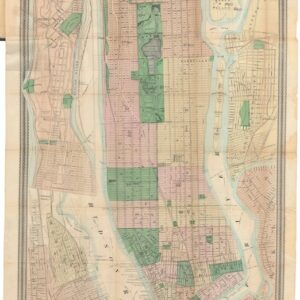Matthew Dripps (1812 – 1896) was an American mapmaker active in Philadelphia and New York during the second half of the 19th century. Dripps was born in Ireland and worked as a grocer in Belfast during his youth. In 1849, he emigrated to the United States, booking passage on a steamer from Belfast to Philadelphia, where he worked as a tax collector. Dripps’ first map was of Philadelphia and was compiled during Dripps’ first year in the United States. By 1850, Dripps moved to New York, setting up a map publishing business in Brooklyn. He knew that for his company to be successful, he needed to make his mark as a mapmaker, so he began working on a monumental mapping of Manhattan. The project took almost two years to complete, but it got the right people’s attention – including the New York City Council, who began relying on Dripps’ maps for official purposes like the census.
Following his initial success, Dripps soon specialized in city maps – especially of New York and Philadelphia. He published many different maps, ranging from monumental to pocket-sized. Among his output were several key maps of Brooklyn, which was undergoing massive and rapid development at the time. In some cases, his maps were explicitly made for local authorities like the New York City Clerk’s office. In many cases, Matthew Dripps would issue revised editions of his maps, updating old templates with new neighborhoods and land developments.
In his private life, Dripps was married and had six children. He was buried at Greenwood Cemetery in Brooklyn after his death in 1896.
-
-
Add to cartQuick View
- United States, East & Midwest United States
Map of New York and Vicinity.
- $1,200
- From city to metropolis: Matthew Dripps’ rare folding map of New York.
-
Add to cart
